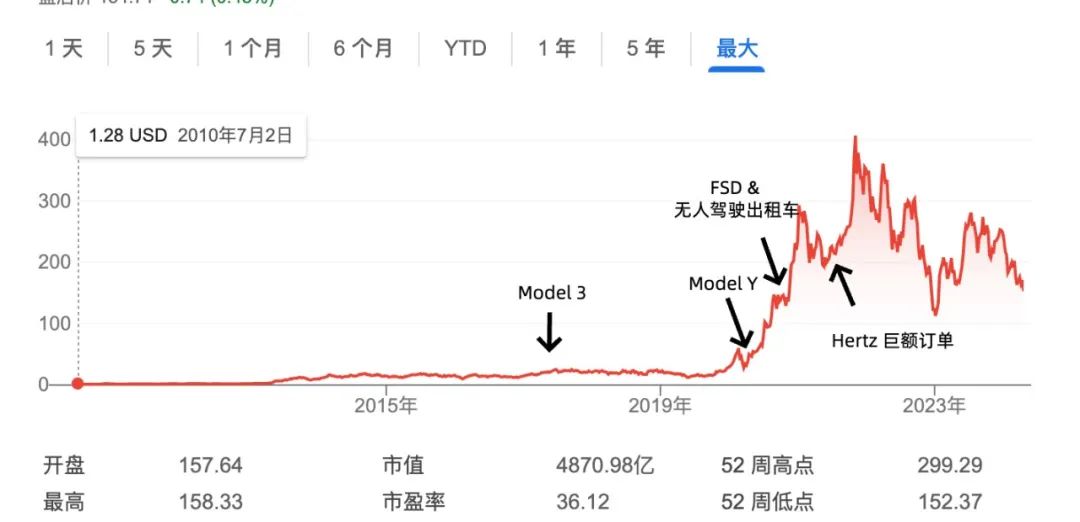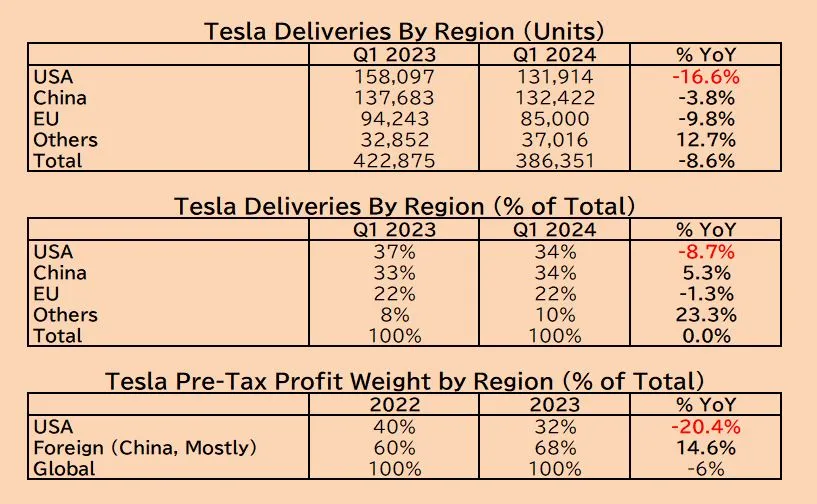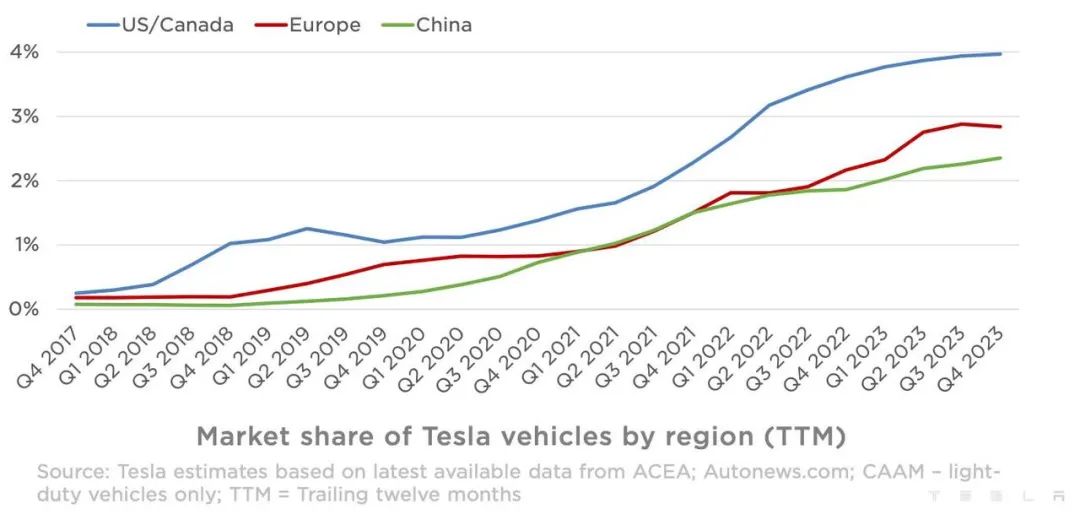Author: RockFlow
Key points:
① ARK's Ark Fund currently holds nearly $8 billion in Tesla stock, making Tesla the largest holding in its ARKK fund. This indicates Cathie Wood's unwavering confidence in its future, believing that Tesla's return to the top is only a matter of time.
② Major fluctuations in Tesla's market value in history have been closely related to the official launch of its strategic products. However, the substantial progress of new businesses (such as autonomous driving and car leasing) is not clear at present, and the expected delivery growth in 2024 is still uncertain, facing many pressures to return to an upward cycle.
③ With the delay of cheaper car models and the Cybertruck unable to make a meaningful contribution to performance in the short term due to production capacity constraints, Tesla is placing too many possibilities on the not fully prepared FSD and the yet-to-be-launched Robotaxi robot taxi business.
"I do see a path for Tesla to become the most valuable company in the world. I believe that it is not an easy path, in fact, it is very difficult, but it is now possible, and I did not have this idea before."
This is a statement repeatedly mentioned by Musk at the Tesla earnings conference call last quarter. He previously stated that Tesla's market value could surpass the sum of Apple and Saudi Aramco within the next five years.
However, reality has not been as expected. Since the last earnings report, Tesla's stock price has fallen by over 20%. Its decline in 2024 is close to 40%, and its latest market value has fallen below $500 billion. In addition, the company is undergoing a global layoff of no less than 10%, and several senior executives have chosen to leave.
Amidst the turmoil, Cathie Wood, a well-known fund manager who has long favored growth stocks, chooses to believe in Tesla and has been increasing her holdings.
According to ARK's Ark Fund disclosure, Tesla has once again become the largest holding in its flagship fund, ARKK, with holdings of $7.27 billion in Tesla stock, accounting for 9.85% of ARKK's weight (very close to the default 10% single stock limit), surpassing Coinbase with a weight of 9.11%. This indicates that Cathie Wood's confidence in Tesla's future has not waned, and she believes that Tesla's return to the top is only a matter of time.
Will Tesla break away from the ranks of tech giants? When will it regain its glory? The RockFlow research team has conducted in-depth research on the historical fluctuations in its stock price, the reasons for its poor performance over the past year, and the recent controversies surrounding Model 2 and Robotaxi. We believe that Tesla's business has enough resilience, and although its stock price has been in a slump for a period of time due to industry cycle fluctuations, it is still full of hope.
1. The driving force behind Tesla's stock price rise
Looking back, Tesla's major market value fluctuations have been closely related to the official launch of its strategic products:

2013-2016: Tesla was a luxury car manufacturer based on the high-end market, producing high-priced Model S and X luxury cars and SUVs. Similar to brands like BMW and Mercedes, during this period, Tesla focused on stylish, high-end electric sedans and SUVs. At that time, Tesla's market value was only about $30 billion.
2017: The launch of the Model 3 to the mass market in July 2017 drove Tesla's market value to a significant increase for the first time. By demonstrating its ability to produce affordable mid-range electric cars, the market believed that Tesla had the potential to disrupt the broader electric car market.
Early 2020: In March 2020, the launch of the mid-sized Model Y SUV, a more affordable electric SUV, expanded Tesla's potential market size, driving its market value to a second significant increase to $400 billion, far exceeding the industry leader Toyota's $200 billion at the time.
Mid-2020: In September 2020, the launch of full self-driving (FSD) testing and the robot taxi plan propelled Tesla's market value to a third significant increase to $800 billion by the end of 2020. Thanks to further expansion of the total potential market, investment banks such as Morgan Stanley were very bullish on Tesla's prospects.
However, FSD did not land as quickly as expected, and at the time, the market realized that relying solely on these two new businesses could not sustain the $400 billion increase. Tesla's market value experienced a more obvious short-term correction.
2021: In October 2021, U.S. car rental giant Hertz announced an order for 100,000 Tesla cars. Upon this news, Tesla's stock price soared significantly on the same day, and its market value also exceeded $1 trillion.
At this time, Tesla was in high spirits, and the bright prospects of electric cars, energy business, autonomous driving, and robot taxi services all seemed very attractive. However, subsequent reality shattered investors' hopes, and Tesla's stock price experienced a year-long decline until a rebound in early 2023.
At present, the dilemma in 2024 is simply a continuation of the adverse impact of the rebound in 2023 performance. After all, the substantial boost to performance from autonomous driving, car leasing, and the Cybertruck pickup truck is not clear, and the expected increase in car sales for the full year of 2024 is still uncertain, putting considerable pressure on Tesla to return to an upward cycle.
2. Why has it been in a continuous slump for the past year?
Tesla's weak performance is not just a problem of the most recent quarter; the financial data over the past several quarters has also been unsatisfactory. What is most worrying for the market is that in the first quarter of this year, Tesla's deliveries decreased by about 9% year-on-year, lower than the expected 14%, marking the first quarterly sales decline since the pandemic in 2020.
Why were Tesla's first-quarter delivery numbers so disappointing? In all fairness, the core reasons can be attributed to three factors:
First, this can be attributed to the historic interest rate hike cycle. Car sales are cyclical, and interest rate levels directly affect consumer demand for cars. If the interest rate cut comes earlier, the car cycle will warm up, and Tesla's performance is expected to see significant improvement.
Second, a more competitive environment in recent quarters (especially in the Chinese market) has led to a phase of saturation in the electric car market. Given that electric cars are still an emerging industry, more public charging infrastructure, cheaper and more diverse car model choices, and continued upgrades in driving range are needed to further stimulate demand (the adoption of Tesla's charging standards by several car manufacturers is a positive signal).
Finally, the temporary closure of some factories and maintenance has increased Tesla's short-term production and delivery pressures, and such news has to some extent dampened market sentiment.
It is worth noting that Tesla's U.S. business severely dragged down overall deliveries this quarter. The following chart shows Tesla's quarterly delivery data by region, with the largest decline in the U.S. market:

As the U.S. accounted for 32% of global pre-tax profits last year, the RockFlow research team expects that this may have a significant impact on the upcoming first-quarter earnings.
However, to be fair, the entire electric car industry is facing difficulties, and it's not just Tesla that has turned in a poor performance. Although it "only" delivered about 387,000 cars in Q1 2024, Tesla still regained the title of "the world's largest electric car manufacturer"—it had previously lost to BYD, but this quarter, the latter's delivery volume declined by a larger margin, reaching 42%.
In addition to the year-on-year decline in deliveries, Tesla also revealed to the market that its car sales growth in 2024 will be "significantly lower" than in 2023, indicating that the recovery in sales is still a long way off. Furthermore, another thorny issue it faces is the continuous decline in profit margins caused by price reductions.
Tesla's profit margin has always been ahead of other car manufacturers, mainly due to three factors:
1) Economies of scale (the importance of several gigafactories to Tesla is self-evident); 2) Bypassing dealers and directly facing consumers (online and offline direct sales stores); 3) Low marketing costs (Tesla's advertising budget has always been at a very low level).
Due to the long-term lack of new models, in order to prioritize sales and growth, Tesla has had no choice but to continue to reduce prices in the short term to stimulate demand, resulting in very unattractive profit margin data.
Of course, bulls may believe that Tesla's intentional continuous price reductions are aimed at making it more difficult for competitors to compete in a high capital cost environment. When unfavorable factors diminish and growth accelerates again, Tesla will gain a larger market share. Additionally, although it is accepting lower initial profits now, it will reap more profits in the future through additional sales via software (such as FSD autonomous driving).
However, the bearish opposition is also very clear: due to intensified competition in the entire industry, Tesla's price reductions may lead to a long-term decline in its own profit margins. Especially in Europe and China, other lower-cost companies are catching up, weakening Tesla's pricing power in the long term.
The following chart shows the changes in Tesla's market share in the three main regions of North America, Europe, and China over the past six years. It is apparent that its market share growth in recent quarters has become very slow:

However, overall, in terms of market share and profitability, Tesla is still the leader in the electric vehicle field. Its relatively solid fundamentals did not change in 2023.
3. When will Tesla return to the top?
Not long ago, a Reuters report caused fluctuations in Tesla's stock price, stating that Tesla is abandoning the $25,000 economy car (Model 2).
Considering that this low-cost electric car was highly anticipated, and the market had to some extent factored in expectations for its profit growth, when the news came out, Tesla's stock was sold off, and the stock price fell by nearly 6%.
30 minutes later, Musk tweeted, "Reuters is lying again," which helped recover some of the losses, and Tesla's stock price rose in response. However, it still closed down 3.6% on the same day.
49 minutes later, Musk tweeted again, "Tesla Robotaxi will officially debut on August 8th."
This news caused the stock price to rise by 3.8% after hours, greatly exciting fans. However, it also raised doubts among some investors:
First, if Reuters really spread rumors, would Musk urge Tesla's legal team to threaten legal action?
Second, if the Robotaxi is ready to debut, why wasn't it announced when Tesla's stock price hit a dangerously low point in mid-March, and instead waited until Reuters reported the cancellation of the new car?
One possibility is that the market's negative reaction to the Reuters news shocked Musk, and he decided to fight back, thus making a response that exceeded the team's original expectations. Clearly, he is trying to shift the focus from Tesla's deteriorating car business to the company's new positioning in "AI/robots".
For Musk, this also means that the details of the Robotaxi cannot escape the questioning of analysts at the new quarterly earnings conference call on April 23.
Reuters' report on Tesla canceling the Model 2 comes from multiple sources, most of which are suppliers. Given that suppliers of components for new car models from car manufacturers need to be involved in research and development about 2 to 3 years before the new car is launched, it can be inferred that this news has a high degree of credibility.
On the other hand, why does the market attach so much importance to the low-cost Model 2? Because it is crucial for solving Tesla's current urgent need—to boost the profit margin of its car business.
The following chart shows the estimated comprehensive data for the expected price, cost, and profit of the Model 2 compared to Tesla's existing models:

The data in the above chart reveals three key points:
First, the Model 2 is expected to be priced at $25,000, with an expected annual sales volume of over 500,000 units and an estimated gross margin of 22%;
Second, through innovative production processes, the production cost of the Model 2 is expected to be 50% lower than that of the Model 3 and Y;
Third, the expected annual sales of 500,000 Model 2 units will bring in $2.7 billion in gross profit. This means that although the profitability of Tesla's existing old product line has significantly declined, overall profitability will be greatly improved due to the Model 2.
Clearly, this is very important for Tesla, which has not introduced mass-market models for many years.
In hindsight, it may have been a mistake for Tesla to prioritize the Cybertruck over the next generation of cheaper mass-market cars. Launching the Cybertruck is cool, but the market space for this model is not large enough, and due to production capacity constraints (expected to produce 250,000 units per year), it cannot make a meaningful contribution to Tesla's performance in the short term.
All of this ultimately led to Tesla placing too many possibilities on the not fully prepared FSD and the yet-to-be-launched Robotaxi.
We believe that if the FSD and Robotaxi stories are confirmed, Tesla is expected to benefit from car sales and recurring taxi income, and may even generate profits similar to "subscription-based software". This is why Cathie Wood believes that Tesla is conducting the world's largest AI project through autonomous driving. The entire ecosystem of robot taxis indeed has the potential to create trillions of dollars in revenue, and at that time, Tesla as a platform supplier will be the biggest winner.
When will such a future arrive? What surprises will the Robotaxi bring to the market? We wait and see.
免责声明:本文章仅代表作者个人观点,不代表本平台的立场和观点。本文章仅供信息分享,不构成对任何人的任何投资建议。用户与作者之间的任何争议,与本平台无关。如网页中刊载的文章或图片涉及侵权,请提供相关的权利证明和身份证明发送邮件到support@aicoin.com,本平台相关工作人员将会进行核查。



